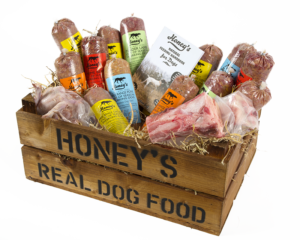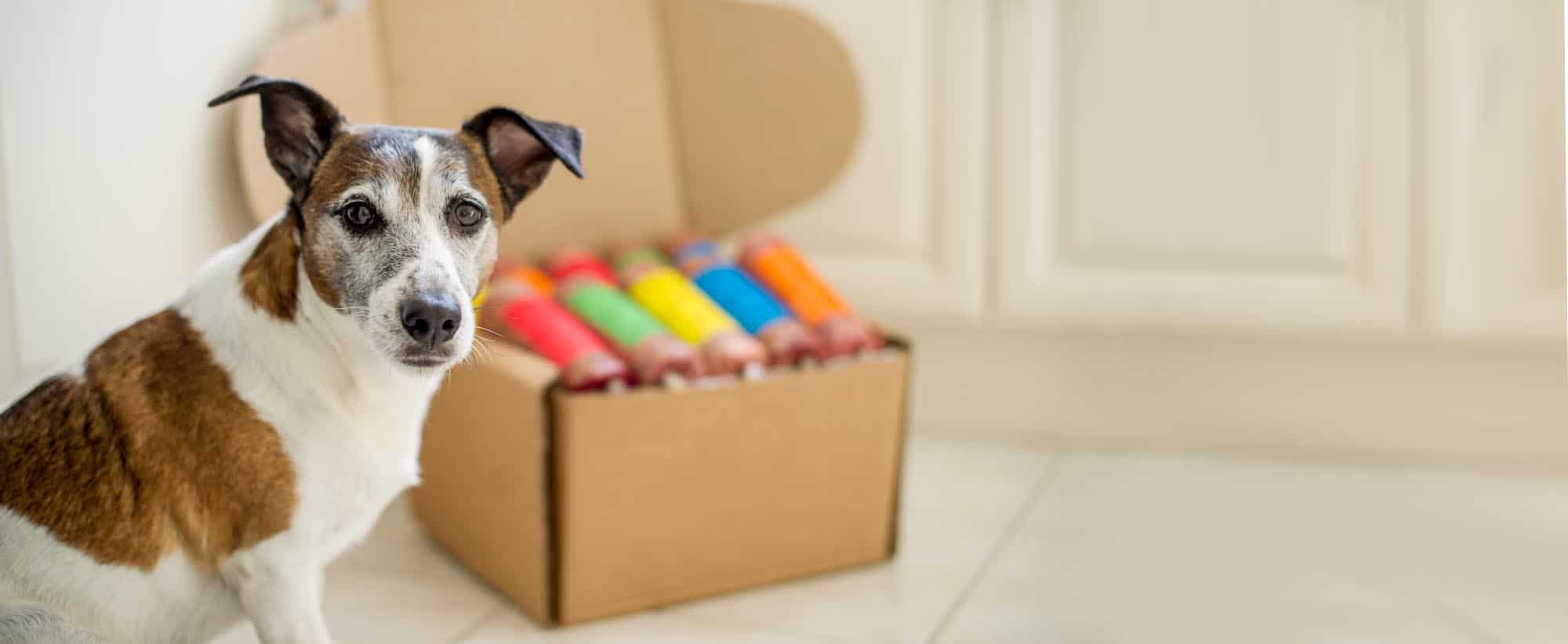Honey’s packaging – everything from the tape that seals our boxes to the ice sheets we use to keep it cold in transit – is 100% recyclable and, where possible, made from recycled materials.
Our packaging policy: reduce, reuse and recycle
However, recyclability is only one part of our packaging policy, which is built on three core principles: reduce, reuse and recycle.
Reducing our packaging

Our starting point when it comes to packaging is to ensure that we use as little of the earth’s resources as possible – not only for the packaging itself, but also for its handling, storage and delivery.
This is best explained with a few examples.
The reason why Honey’s comes in ‘sausages’ (also known as chubs or shires) is because they use substantially less resources than any of the other currently available options.
- A 500g chub of food, for example, requires around 2g of material, compared to around 30g for the equivalent tub and seal or around 36g if a cardboard sleeve is also used. Moreover, chubs take up 20% less space in a freezer than tubs or pouches, freeze down faster and involve minimal wastage.
- Recently, we have been able to do away with most labelling by printing all the relevant information directly onto the chubs.
- By shipping Honey’s frozen we reduce the need for lots of ice sheets and insulation. We make further reductions by adjusting the number of ice sheets and pieces of insulation according to the weather conditions.
Reducing our packaging has been an ongoing process since we were founded in 2009.
We currently use seven separate elements and not a week passes without us considering how we might reduce our use of one or more of them.
Recycling our packaging
Our packaging is 100% recyclable.
We have prepared a special guide that explains how to recycle each element.
If you would like a copy, please contact Honey’s HQ.
We are always looking for ways to reduce the environmental impact of our packaging (see below).
Reusing our packaging
Several items of our packaging lend themselves to being reused. For example:
- The boxes (providing they haven’t been damaged) can be used for storage or moving home.
- The ice sheets can be washed, refrozen and used to keep food and other items cold.
- The insulation can also be washed and used for a variety of purposes (we have one customer, for example, who uses them to line her dogs’ beds, another to keep a larder cold).
Our calculations to date suggest that the resources required to return any item to us for reuse outweighs the environmental benefit.
However, we do review this policy regularly in case the position changes.
Why we haven’t opted for compostable packaging (yet)
Compostable packaging looks great at first sight and we were going to switch to it until a firm of environmental consultants advised us to reconsider.
The issues they raised were:
- Where does the material used to make the packaging come from? Unfortunately, the demand is so great that it has led to huge tracts of land being turned over to monoculture, which in turn destroys biodiversity. The rainforest in Central and South America is, in part, being destroyed to grow crops, which in turn are being used to create compostable packaging. This is madness!
- What does it contain and what effect will it have on the environment after it composts? There is some evidence that compostable packaging actually leaches harmful chemicals into the soil. You’ll find quite a bit online about this. No one is really certain because it is so new.
- Is it leak proof? Compostable tubs have to be sealed with non-recyclable plastic to make them leak proof. Compostable pouches have to be lined with something similar to achieve the same results. As an aside the plastic film on a 500g tub weighs about half the amount of the recyclable plastic we use on our current 500g packaging.
- What is the total size and weight of the material used? Take into account any cardboard sleeves & c. needed. Our chubs are very light when compared to tubs.
- How much freezer space does it take up? Our chubs use 20% less space. This means they freeze faster, require less space to ship and more food can be kept in a smaller space. A 20% saving is not to be sniffed at!
- Does the packaging compost as promised? We have tested home compostable packaging in our own compost heaps, and we have found that it does not break down as promised. Some compostable packaging needs to be put into industrial composting systems.
In short, we don’t think it is quite there yet.
Our future plans

As explained above, one area we consider regularly is that of compostable plastic. We believe that in time it could well be the best option, but to date our existing packaging is better.
Another packaging option we have looked at is ‘waxed’ cardboard cartons.
Again, at this stage, it would appear that the environmental benefits of switching from plastic to ‘waxed’ cardboard are outweighed by the disadvantages.
Many customers have asked us about re-usable wool insulation, but our research indicates that the environmental cost (making it, returning it, washing it) over its likely lifetime outweighs the environmental benefits.
We have also been asked if the insulation we use at present could be returned to us for re-use.
Again, we believe the environmental cost (making it, returning it, washing it) over its likely lifetime outweighs the environmental benefits.
We are currently considering a new insulation material that could mean we can do away with the ice sheets and the plastic bag we currently use.
We also hope that in the future we will be able to use a compostable polystyrene-type material that we have identified, but which is not yet commercially available.
We rely on expert support
Honey’s packaging policy has been developed by our Ethics, Environment & Sustainability Working Party in conjunction with two external resources: a specialist environmental consultancy, Ryeden, and a separate carbon expert: Dr Simon Forsythe.
We welcome your ideas and input
If you have any ideas or input as to how we could further improve our environmental management please contact our founder, Jonathan, using his personal email address: jonathan@honeysrealdogfood.com
